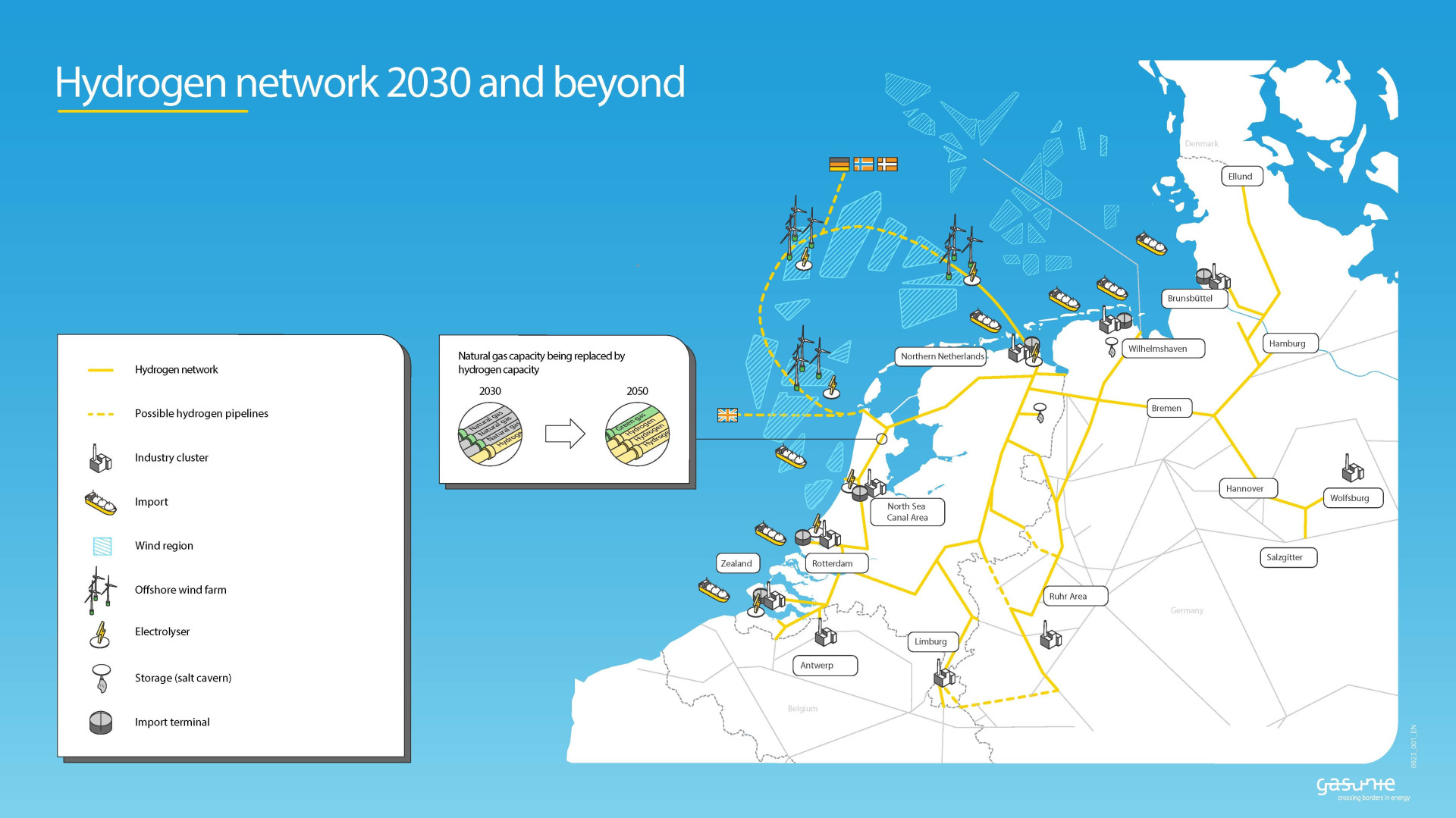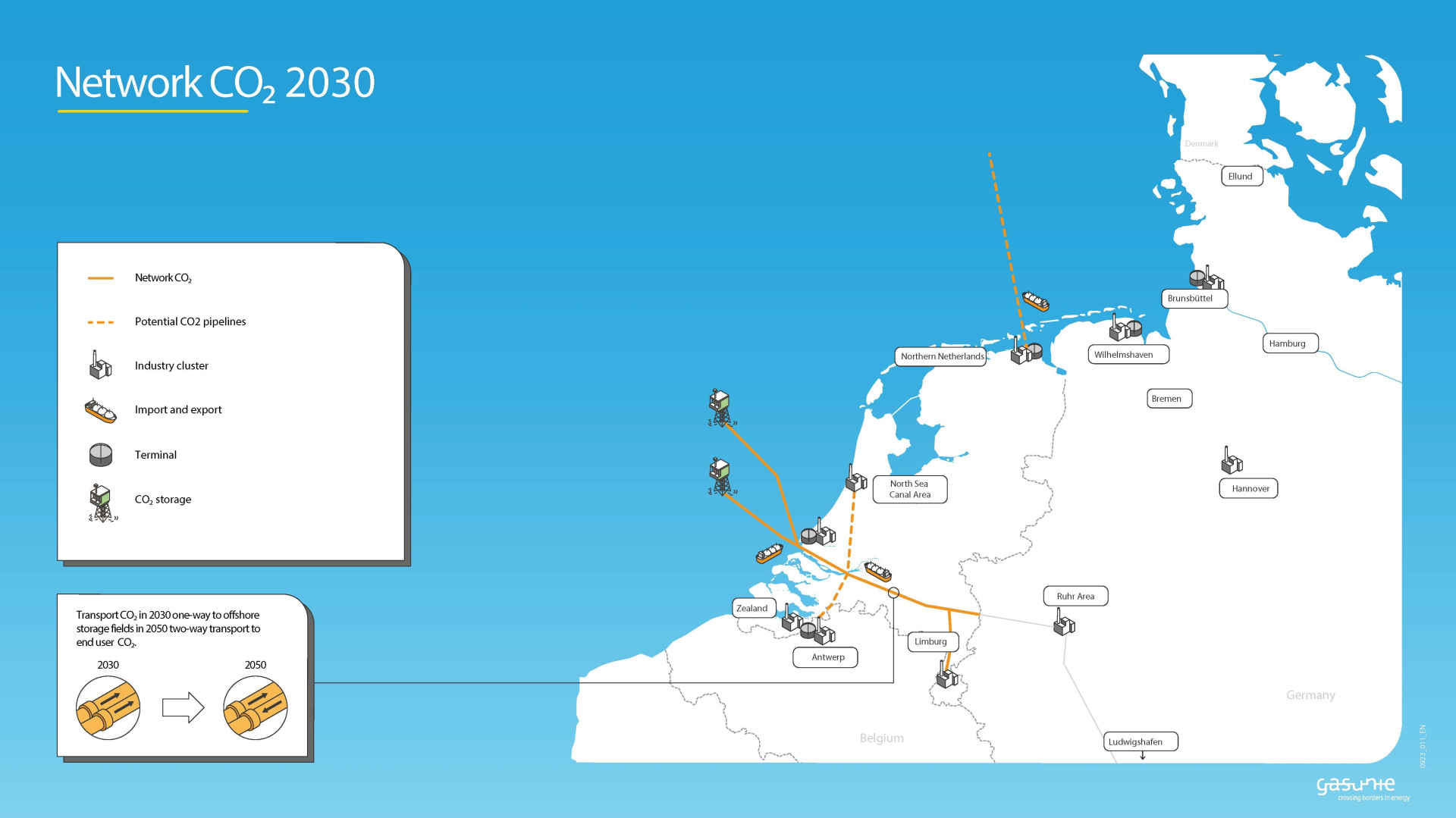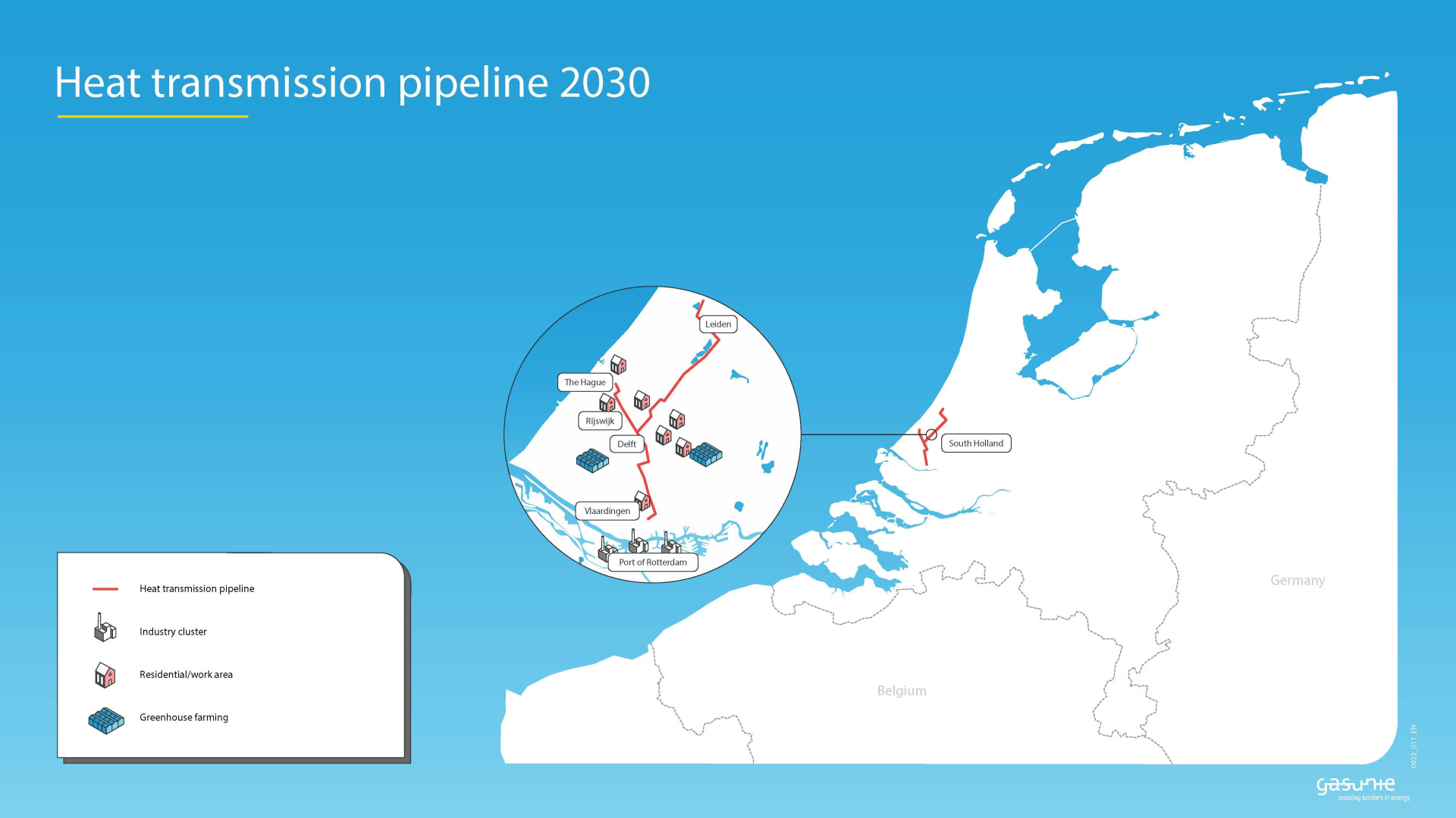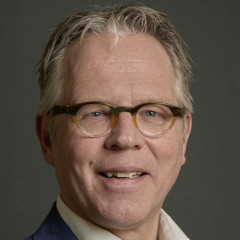Energy transition
Energy transition
Gasunie is clearing the way for the transition society is making to a carbon-neutral energy system. We are installing the infrastructure for hydrogen, CCS, heat and green gas, with the result that, over the coming years, we will transform from a gas TSO to an energy infrastructure company.
Our contribution to the National Transition Pathway
The energy transition projects Gasunie is developing will enable Gasunie grid users to cut many megatonnes of emissions in the coming years.
Gasunie will help grid users cut many megatonnes of emissions on the way to 2030*
* We published a similar table in the 2022 annual report. Our expectations at that time were:
- for hydrogen: (2025: 0.9); (2026: 2.5); (2027: 3.0); (2028: 3.5); (2029: 5.2); (2030: 6.7); and
- for CCS: (2025: 1.3); (2026: 2.5); (2027: 5.6); (2028: 8.8); (2029: 12.5); (2030: 12.5).
The Netherlands aims to be climate neutral by 2050. To get there, as a country the Netherlands must cut its carbon emissions every year over the coming decades: it needs to follow what’s called the National Transition Pathway (see the yellow line in the visual below). However, as can be seen in the Climate and Energy Outlook (C&EO) report published by PBL Netherlands Environmental Assessment Agency, the Netherlands is lagging behind on this pathway (see the dotted line).
If Gasunie were to be facilitated in implementing its current investment programme in the coming years completely and without delay, we in turn would be able to facilitate the Netherlands in closing a significant part of the gap between the Climate and Energy Outlook and the Transition Pathway. We think that, through our energy transition projects, grid users can cut 25.6 Mt of carbon emissions by 2030. To illustrate: the Netherlands’ total carbon emissions in 2022 were 158.4 Mt*.
* Statistics Netherlands (CBS), Emissions of greenhouse gases according to IPCC guidelines.
Gasunie investments in Hyperlink cut carbon emissions in Germany by megatonnes
Our investment plans in the German national hydrogen transmission network Hyperlink can also deliver several megatonnes of additional carbon cuts and contribute to Germany moving further along its transition pathway.
Investments ensure that the Netherlands does not lose sight of the Transition Pathway
(figures in Mt/year)
The chart above shows the avoided emissions in the Netherlands facilitated by Gasunie; for 2030 these are expected to be 25.6 megatonnes (Mt). If other sectors in the economy play their part, the rest of the gap can be closed, too, and we will stay on track to become carbon neutral in the Netherlands by 2050*. Gasunie’s transition investments mainly ensure carbon reductions in the industry and built environment sectors.
* We explain our calculations in the Additional information section found at the end of this annual report.
Other sectors must also play their part in closing the gap
(figures in Mt/year)
This effect of our investments up to the end of 2030 is also apparent if we extend the horizon to 2050, as shown in the visual below. Users of the Gasunie infrastructure will then emit less CO2 (see the yellow area) and can even achieve climate neutrality earlier than the national target date.
Gasunie infrastructure users could already be climate neutral before the target date
(figures in Mt/year)
Gasunie will still have a big job ahead of it after 2030. The hydrogen system in particular will need to be expanded, and we also foresee further growth in green gas and follow-up investments in the transmission of CO2. A technical explanation of our contribution to the National Transition Pathway is included as an appendix to this annual report. We recalculate this contribution annually, taking the latest knowledge and insights from within the company and from external parties into account. Since the previous annual report, we are now dealing with a new Climate and Energy Outlook, later commissioning at the Porthos project but higher reduction levels, and lower-than-expected utilisation of the national hydrogen transmission network.
Gasunie Transition Pathway Calculator
To make our social contribution to making the Netherlands carbon neutral even more transparent, concurrently with the publication of this annual report Gasunie is publishing an interactive online Gasunie Transition Pathway Calculator. In our base scenario, all new-build projects between now and 2030 will be operational by the delivery year we have set. Using this calculator, everyone can calculate the situation in more favourable and less favourable scenarios. Our Transition Pathway Calculator currently only considers the effects of our investments between 2020 and 2030. A new series of Gasunie investments for the period from 2030 to 2050 could lead to a steeper decline along the Dutch transition pathway.
Our hydrogen projects
Network
A prerequisite for the development of a hydrogen market is having in place the infrastructure for the import, transmission and storage of hydrogen. The Netherlands and the north-western part of Germany are ideally positioned to serve as a gateway for hydrogen entering Europe.
We are aiming to be the first European country to have our hydrogen infrastructure in order, positioning the Netherlands to become a key hub for hydrogen. In October, at the Tweede Maasvlakte industrial park in Rotterdam, King Willem-Alexander officially launched the construction of the first section of hydrogen pipeline, which will ultimately span a total of 1,200 kilometres*. This network is being developed by Gasunie subsidiary Hynetwork Services; a large portion of the network will consist of repurposed gas pipelines from Gasunie subsidiary GTS. After the Rotterdam grid, we plan to make an investment decision in 2024 for the northern and south-western pipeline sections in the Netherlands.
* The national hydrogen grid will likely be expanded further after 2030.
The war in Ukraine has given rise to changes in the gas market that impact when the GTS pipelines that are to be repurposed will become available; specifically, we will need to continue using the IJsselmeer pipeline as a west-east connection for gas transmission for now and so, for the time being, it cannot be repurposed for the transmission of hydrogen. To see that we are still able to transport hydrogen from west to east, in May 2023 Gasunie joined the Delta Rhine Corridor, a collection of initiatives that also includes a hydrogen pipeline to be built by Hynetwork Services.
In November, FNB Gas (association of German gas TSOs) submitted its draft application for the hydrogen core network (Wasserstoff-Kernnetz) to the German Federal Ministry for Economic Affairs and Climate Action. Gasunie, together with eleven other gas TSOs, contributed to the development of this core network plan, which should be finalised in early 2024. Initial work on Gasunie’s part of the German hydrogen core network, Hyperlink, is now underway. Next year, work will be done at more than thirty locations to prepare existing pipelines for the transmission of hydrogen.
In November, Hynetwork Services signed a cooperation agreement with German TSOs Open Grid Europe and Thyssengas on connecting the national hydrogen transmission grids between the Netherlands and Germany. At the same time, six energy companies (BP, Uniper, E.ON/Essent, Onyx Power, Equinor and Engie) signed a declaration of intent stating that they intend to transport hydrogen via the Netherlands to industrial and other customers in Germany.
In the spring of 2023, Germany and Denmark signed an agreement concerning a hydrogen pipeline to be built between the northern region of Germany and the western region of Denmark, in which Hyperlink can play a role due to its prime location for this.
Imports
It is clear that the demand for hydrogen will far outstrip Dutch production in the coming decades. The Dutch Ministry of Economic Affairs and Climate Policy takes the same view and so has, together with Gasunie and other state subsidiaries, organised several trade missions to Chile, South Africa and other countries.
Import corridors are also being set up closer to home. Spanish energy companies Cepsa and Iberdrola signed letters of intent with Gasunie and ACE Terminal to establish a green hydrogen value chain between Spain and the Netherlands. In these letters of intent, the parties express their desire to import green ammonia to the Netherlands by way of the planned ACE import terminal at the Port of Rotterdam, and from there to transport green hydrogen to European customers via the Dutch national hydrogen transmission network.
In 2024, potential import corridors with other countries will be developed and the plans for Dutch import terminals ACE Terminal and EemsEnergyTerminal (Eemshaven) and German LNG Terminal (import terminal in Brunsbüttel) will be developed further.

Offshore
Hydrogen is set to play an essential role in the energy transition. The Dutch government is investigating the possibility of installing 70 GW of offshore wind energy capacity in 2050. With our offshore hydrogen strategy, we aim to unlock the enormous potential of generating power in the North Sea for the production of offshore green hydrogen and bring this hydrogen to shore. Moreover, we want to set up international connections to enable Gasunie to supply additional hydrogen to the Dutch and north-western European markets.
The first successes in this regard were already achieved in 2023. For one, € 50 million from the budget of the Ministry of Economic Affairs and Climate Policy has been earmarked for Gasunie to develop the offshore hydrogen network. Gasunie is a major partner in various research undertakings investigating the feasibility of an offshore network in the North Sea. We also explicitly take into account the desire for the network to become nature inclusive and nature enhancing.
An important ongoing study is the North Sea Energy Infrastructure Plan 2050, commissioned by the Ministry of Economic Affairs and Climate Policy. This strategic plan for development of the infrastructure required for offshore wind energy in the 2030 to 2050 period is expected to be finalised in 2024.
Storage
Large-scale storage of hydrogen is one of the prerequisites for a well-functioning hydrogen market, and Gasunie subsidiary HyStock is already hard at work on realising this. In Zuidwending, near Veendam in the province of Groningen, Gasunie stores natural gas in six salt caverns. We also plan to develop hydrogen storage facilities at this location.
At the beginning of 2023, we completed the A8 hydrogen storage demo project at our Zuidwending site. This project demonstrated that hydrogen can be safely stored in a salt cavern. HyStock is working on the design of the above-ground plant and the permitting process for the storage of hydrogen in the first cavern. In 2023, market parties were invited to bid for future storage capacity in this cavern; the requested reservations far outstripped the available storage capacity of 216 GWh.
In Germany, together with its partner STORAG ETZEL, Gasunie is participating in the H2Cast pilot project, aimed at gaining knowledge and experience in making two existing salt caverns suitable for the storage of hydrogen. Gasunie will connect the two caverns via an above-ground installation. These caverns are close to the future hydrogen network Hyperlink and to Wilhelmshaven.
In the coming years we will continue to work on hydrogen storage at the Zuidwending facility and investigate alternatives for storage in other regions in the Netherlands and in Germany.
Our CCS projects
There are various solutions that can prevent the concentration of CO2 in the atmosphere from rising further. One of the most cost effective of these in the short term involves capturing carbon emissions, transporting these and storing them underground: carbon capture and storage, or CCS. In the Netherlands, CO2 will be stored in empty gas fields below the North Sea bed. With CCS, rather than just having an impact over the long term, we can have an impact on the amount of CO2 in the atmosphere right away, and at a low cost to society. Together with partners, Gasunie is working on four large, concrete CCS projects, Porthos, Aramis, CO2next and Delta Rhine Corridor.
Porthos
In 2023, Gasunie, EBN and the Port of Rotterdam Authority took the final investment decision for Porthos. This was made possible after the Dutch Council of State ruled that the nitrogen oxide that would be emitted during construction would have no significant impact on nearby nature reserves. In 2024, the construction of the first major carbon transport and storage system in the Netherlands will start in Rotterdam. This decision marks a pivotal moment in terms of setting future developments in carbon storage in the Netherlands in motion. We expect the Porthos CCS system, which involves an investment of € 1.3 billion, to be ready in 2026.
Air Liquide, Air Products, ExxonMobil and Shell will capture CO2 and supply this to Porthos, investing in their individual carbon capture systems on their own. Porthos will then transport the captured CO2 via pipeline from the Port of Rotterdam to depleted gas fields approximately 20 km off the Dutch coast, where it will be stored permanently 3 to 4 km below the seabed of the North Sea. Porthos will store around 2.5 Mt of CO2 per year over a period of 15 years, for a total of about 37 Mt, around the full capacity of Porthos. It will be possible, however, to later use the onshore transmission system that is being built for future CO2 storage projects too.
Aramis
Aramis has reached the FEED phase. The partners involved in the project – TotalEnergies, Shell, EBN and Gasunie – reached an agreement in December on the further development of key parts of the required infrastructure, including the offshore transmission pipeline, which will have a maximum capacity of 22 Mt/year. This brings the realisation of the largest CCS project in north-western Europe one step closer.
We expect that the design will be ready in 2025, after which the final investment decision can be taken and, assuming this is positive, the actual construction of the transmission infrastructure can start. According to the current schedule, the Aramis project will be operational by the end of 2028, provided all the requisite permits have been obtained. From that moment on, industrial parties can transport their CO2 via the Aramis transmission pipeline to various depleted gas fields under the North Sea. Unlike with Porthos, Gasunie will only be responsible for transmission: storage will be organised by the consortium partners.

DRC
The Delta Rhine Corridor (DRC) is a collection of initiatives to simultaneously construct multiple underground pipelines and direct current connections between Rotterdam and the German border, via Moerdijk and Geleen (NL). As a consortium party in the DRC, Gasunie wants to build and manage a hydrogen pipeline and CO2 pipeline. The corridor also offers space for other types of pipelines and cables. In 2023, we drafted an initial design for the technical system for the CO2 component. As regards the commercial aspect, we are preparing to start an open season for capacity in the CO2 pipeline in the Netherlands in early 2024.
Heat
Gasunie is constructing WarmtelinQ, an underground system of pipelines stretching out over 56 km to transport waste heat from the Port of Rotterdam to residential areas in the cities of Vlaardingen, Rijswijk, The Hague and Leiden, as well as other locations. Through this pipeline we will transport waste heat from the Port of Rotterdam that our customers can then use to heat homes, businesses and commercial greenhouses. The total capacity of the WarmtelinQ main heat network will be 250 Megawatts thermal (Mwth), enough to heat approximately 120,000 homes. This will result in a saving of around 0.18 megatonnes of CO2 per year.

The project aimed at having the heat transmission pipeline between Vlaardingen and The Hague operational in 2025 and the branch to Leiden transporting heat in 2027 is on schedule. The work in The Hague started just after the summer of 2023. For the section to Leiden, at the end of 2023 the team sent the final version of the EIA report and the provincial zoning amendment plan to the Zuid-Holland Provincial Executive.
Green gas
Under the Dutch Climate Agreement, the Netherlands has set itself the target of producing 2 bcm of green gas annually by 2030; this is currently around 0.25 bcm. Gasunie sees many opportunities for market parties to scale up the production of green gas and wants to facilitate this by making it possible to feed green gas into the Gasunie network.
Starting in early 2024, Gasunie will convert 60 km of natural gas pipeline running between Emmen and Ommen for the transmission of locally produced green gas to the Gasunie network. This requires a number of technical adjustments at existing Gasunie valve locations and on connections with the regional networks. This includes the installation of a green gas booster. Work is underway on three connections to the green gas gathering pipeline for the regional grid operators Rendo (in and around Coevorden) and Coteq (in and around Hardenberg).
Gasunie Deutschland is currently confronted with numerous requests from green gas producers to have their facilities connected to the grid. There are two reasons for this sudden surge. On the one hand, the German government’s 20-year subsidy period for generating power using green gas produced is coming to an end. On the other hand, the local and regional distribution networks are not able to handle the additional feed-in of green gas on an ongoing basis.
This presents a challenge to German TSOs, who are legally required to connect green gas production facilities, albeit depending on technical feasibility. In 2023, GUD started on the connection for a biomethane plant in the Kirchlinteln/Armsen area; the project should be operational in the spring of 2024.
Eemsgas
Based on the FEED study completed at the end of 2022, Perpetual Next and Gasunie evaluated the Eemsgas plan in 2023. The shareholders are now investigating alternative technologies for the gasification plant, which will produce green gas based on woody waste flows. Prerequisites are that the technology must be commercially feasible and scalable and must be able to make a significant contribution to the 2 bcm target. A new technology was selected in 2023 and based on this, the project will be revised in early 2024 in such a way that an investment decision around the end of 2024 remains feasible.
Alkmaar SCW gasification plant
The supercritical water gasification (SCW) plant in Alkmaar fed gas into Gasunie’s high-pressure network on a regular basis during several short-term test periods in 2023. This was cause for the Minister for Climate and Energy Policy to visit the plant in person on 13 February 2023. Over the course of the year, SCW Systems paid a lot of attention to optimising the entire value chain needed for making green gas using the company’s SCW technology and making this value chain robust. All gasifiers are now ready to use once the congestion on the power grid in Boekelermeer (Alkmaar) has been resolved. The goal for 2024 is to successfully complete an endurance test over 2,500 hours to mark the start of the regular, ongoing production of green gas.
‘First dates’ to match hydrogen supply with hydrogen demand
Hydrogen producers and buyers connect on Match & Connect
Gasunie firmly believes that hydrogen will be an indispensable link in the energy system of the future. This does mean, however, that hydrogen producers and hydrogen consumers must be able to connect; We noticed that companies have great ambitions, but could use some help connecting supply and demand. That was the incentive behind Gasunie introducing the Match & Connect online platform, as a tool for developing the hydrogen value chain.
Connecting online
As far as we know, Match & Connect is the first of its kind in the world. It’s not a trading platform; it can perhaps be better compared with a dating site. End users, producers and shippers (traders) from all over the world can create an online account and get in touch with each other. Once the market parties have connected, it is up to them to reach agreements outside Match & Connect. Gasunie does not play an active role in matching market parties: we facilitate the platform, but otherwise have no access to the profiles or communication between the parties.
Positive response
Match & Connect was officially launched in May 2023, during the World Hydrogen Summit in Rotterdam – the perfect opportunity to showcase what Gasunie can do for the hydrogen market. Users from many countries and continents started using the platform immediately, and 169 profiles had been created on the platform by the beginning of February 2024.
The hydrogen market will likely grow enormously. Match & Connect is a useful tool to help this young market mature. It’s great that Gasunie has taken the initiative in this; this strengthens the Netherlands’ position in the hydrogen domain and is a good fit with the role that the Netherlands wants to play.

